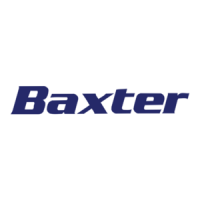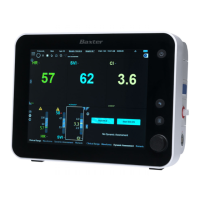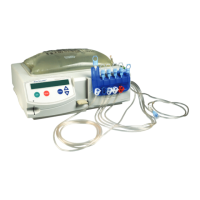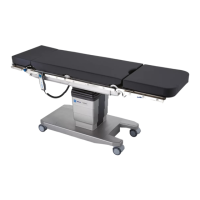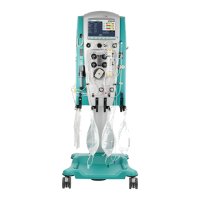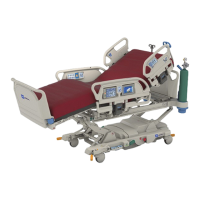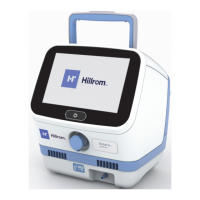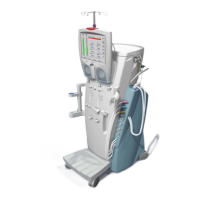
Do you have a question about the baxter ARENA and is the answer not in the manual?
| Category | Medical Equipment |
|---|---|
| Power Requirements | 100-240 VAC, 50/60 Hz |
| Manufacturer | Baxter |
| Capacity | Varies depending on configuration |
| Connectivity | Ethernet |
| Dimensions | Varies depending on configuration |
| Weight | Varies depending on configuration |
Overview of the Arena Hemodialysis Instrument and its functions.
Detailed description of the instrument's components and capabilities.
Outlines the different instrument configurations and available optional features.
Essential safety warnings, cautions, and definitions for instrument operation.
Lists other relevant documents and resources for the instrument.
Lists the necessary tools and equipment for instrument service.
Details the procedures for verifying system functionality after part replacement.
Information on how manual updates are distributed and tracked.
Contact information for technical assistance and submitting feedback.
Describes the modes the Instrument goes through from power on to the start of treatment.
Details the Prime, Dialyze, and Alarm modes during patient treatment.
Explains modes like Heat Disinfection, Cool Down, Chemical, and Shut Down.
Covers Calibration Mode and Technician Mode for service personnel.
Explains the instrument's function in heating, mixing, and infusing dialysate.
Details components and flow within the dialysate circuit.
Covers additional components like the rinse valve and citric acid valve manifold.
Describes the overall electronic system architecture and board identifiers.
Details power requirements, input power distribution, and components.
Explains the card cage housing and the different printed circuit boards.
Explains how the instrument controls dialysate temperature using a redundant system.
Describes the system managed by UF-Proportioning boards for dialysate temperature control.
Details how temperature is monitored and primary alarms are generated.
Covers safety tests performed during self-test for temperature control.
Explains the system for keeping internal cabinet temperature for optimal component operation.
Describes the proportioning ratios for acetate and bicarbonate concentrates.
Explains how operators set sodium and bicarbonate levels for the entire treatment.
Details the system of fixed volume pumps and metering devices for dialysate.
Explains how the UF-Proportioning system controls ratios and flow rates.
Describes the deaeration, dialysate, and supply pumps in the flow path.
Explains how the instrument controls fluid removal using a flow equalizer.
Details control of UF removal rate and accumulated UF volume.
Describes the primary hydraulic components: Flow Equalizer and UF flow meter.
Outlines the operator steps for controlling fluid removal during treatment.
Explains the UF Profiling option for setting UF rates throughout treatment.
Defines important terms related to disinfection and cleaning.
Presents alternative ways to disinfect the fluid path and recommended methods.
Details heat clean procedures, cool down, and auto-off options.
Covers single pass and dwell chemicals, their uses, and precautions.
Describes the monitor for verifying disinfectant infusion and alerting the operator.
Explains the peristaltic pump's role in moving extracorporeal blood and its control system.
Details the mechanical and electrical components of the blood pump assembly.
Covers the blood pump doors, magnets, and reed switches for safety.
Explains the seven major parts of the blood pump rotor assembly.
Describes the Blood Pump Controller and Power Board functions and block diagram.
Explains the purpose of heparin and the instrument's automatic infusion capability.
Details the electromechanical syringe pump elements and their functions.
Explains the heparin pump's states, motor control, monitoring, and bolus infusion.
Covers common troubleshooting issues like overspeed, arm failure, and overpressure alarms.
Describes the configurations and hardware for monitoring extracorporeal circuit pressures.
Explains the calculation and monitoring of Transmembrane Pressure (TMP).
Details the Noninvasive Blood Pressure Monitor option and its troubleshooting.
Explains the optical sensor's function in detecting blood and saline.
Describes the ultrasonic sensor's function in detecting air bubbles.
Explains the optical device used to detect internal blood leaks into the fluid path.
Details the assembly, harness, LED, photocell, and housing of the BLD.
Explains how the BLD monitors the photocell signal and triggers alarms.
Describes the flow restrictor located after the BLD and its importance.
Covers troubleshooting false BLD alarms and UF System 2 errors.
Explains the system for initializing instrument settings with patient data.
Details the desktop instrument used to program Patient Data Cards.
Describes the PDC as a protected memory device for patient treatment data.
Explains the device that reads and verifies patient information from the PDC.
Provides a table of common PDC errors, probable causes, and possible solutions.
Describes routine maintenance required for proper instrument care.
Details routine, annual, and as-required maintenance tasks.
Provides procedures for cleaning specific components like the blood leak detector and fan filter.
Explains the overview and procedure for replacing O-rings in connectors.
Details the overview and procedure for replacing particle filters.
Describes the replacement of flow equalizer diaphragms during annual maintenance.
Outlines the replacement of the UF flow meter diaphragm during annual maintenance.
Details the procedure for assessing and disinfecting A/V pressure transducer components.
